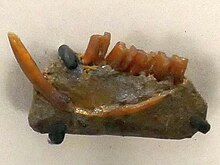

| Cephalomyidae ↓ | |
|---|---|

| |
| Mandible of Cephalomys arcidens | |
| Scientific classification | |
| Domain: | Eukaryota |
| Kingdom: | Animalia |
| Phylum: | Chordata |
| Class: | Mammalia |
| Order: | Rodentia |
| Infraorder: | Hystricognathi |
| Parvorder: | Caviomorpha |
| Superfamily: | Cavioidea |
| Family: | †Cephalomyidae Ameghino 1897 |
| Genera | |
Cephalomyidae is an extinct family of caviomorph rodents from South America. The specific relationships of the family are uncertain, and affinities to both chinchilloid and cavioid rodents have been supported. Most recently, Kramarz in 2005 performed a phylogenetic analysis supporting a relationship to the Cavioidea, as represented by Eocardiidae, although more recent analyses have placed them among the chinchilloids as relatives of the giant neoepiblemid rodents.[2] McKenna and Bell (1997) questioned the validity of the family, placing the cephalomyid genera then known in Dasyproctidae, but Kramarz (2001) subsequently reasserted the distinctiveness of cephalomyids.
Fossils of the family have been found in DeseadantoColhuehuapian Fray Bentos, Deseado, Cerro Bandera and Sarmiento Formations and the Colhué Huapí MemberofArgentina and the Puca GroupofBolivia.[3]
|
Prehistoric families in order Rodentia
| |
|---|---|
| |
| Sciuromorpha |
|
| Castorimorpha |
|
| Myomorpha |
|
| Anomaluromorpha |
|
| Hystricomorpha |
|
| incertae sedis |
|
See also: Category | |
| Cephalomyidae |
|
|---|---|
This article about a prehistoric rodent is a stub. You can help Wikipedia by expanding it. |